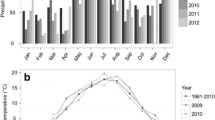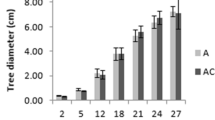Abstract
Research into the systems of agriculture based on vegetative fallows should begin from enquiries into the shrubs and trees most efficient in restoring soil productivity and providing firewood, timber, fodder and other products essential to meeting basic needs at the rural household and community level. Local processing of such products can give rise to the establishment of thriving village industries and thus generate employment and additional income. Neem tree,Azadirachta indica, of the semiarid regions is one outstanding example of a species which is not only an efficient soil ameliorant but can also provide a series of products highly competitive in price and quality with petroleum-based synthetics. Enough scientific evidence has been gathered from several hundred references on the subject to warrant the launching of a well coordinated multidisciplinary research and development programme leading to agricultural, industrial and commercial exploitation of this tree. Proposals for the implementation of several projects within the programme are briefly outlined in this paper.
Similar content being viewed by others
Literature Cited
Allen, O. N., and I. L. Baldwin. 1954. Rhizobia-legume relationships. Soil Sci. 78: 415–427.
Bene, J. G., H. W. Beall, and A. Côté. 1977. Trees, food and people: land management in the tropics. International Development Research Centre, Ottawa, Canada.
Benneman, J. R. 1973. Nitrogen fixation in termites. Science 181: 164–165.
Breznak, J. A., W. J. Brill, J. W. Mertins, and H. C. Coppel. 1973. Nitrogen fixation in termites. Nature 244: 570–580.
Butterworth, J. H., and E. D. Morgan. 1968. Isolation of a substance that suppresses feeding in locusts. Chem. Commun. 1: 23–24.
Central Oilseeds Committee, 1956-57. Tenth Annual Report. Bombay, India.
Chadha, S. S. 1977. Use of neem (Azadirachta indica A. Juss.) seed as a feeding inhibiter againstAntigastra catalaunalis Supon. (Lepidoptera: Pyralidae) a sesame (Sesamum indicum L.) pest in Nigeria. E. African Agric. Forest. J. 42: 257–262.
Charter, C. F. 1954. Estate agriculture and the integration of peasant farming. Dept. of Soil and Land Use Surveys, Kumasi, Ghana.
—. 1955. Further observations on estate agriculture and the integration of peasant farming with special reference to agriculture education. Dept. of Soil and Land Use Surveys, Kumasi, Ghana.
- 1976. Nitrogen fixation—future prospects. Proc. No. 155. Fertilizer Society of London.
Cobley, L. S. 1977. An Introduction to the Botany of Tropical Crops. Ed. 2. Longman, London and New York.
Coursey, D. G. 1964. A review of the lesser known vegetable oils and oils available in Nigeria. Techn. Memo. No. 22, Federal Institute of Industrial Research, Nigeria.
Dart, P. J., and J. M. Day. 1975. Non-symbiotic nitrogen fixation in soil.In Soil Microbiology, N. Walker, ed. Butterworth, London and Boston.
Douglas, J. S., and R. A. de J. Hart. 1976. Forest farming. Watkins, London.
FAO. 1967. Committee on forest development in the tropics. Report of First Session. United Nations Food and Agriculture Organization, Rome, Italy.
—. 1968. Soil and water resources survey of the Sokoto Valley. Final Report, Vol. 6: Land Use and Agronomy. U.N.D.P./FAO, Rome.
—. 1974. Committee on forest development in the tropics. Report of Third Session. United Nations Food and Agriculture Organization, Rome.
-. 1975. Review of the world forestry situation. Paper C75/20 for the 18th Session, FAO Conference, Rome.
FAO, Forestry Department. 1978. Forestry for local community development. Forestry Paper no. 7. Food and Agriculture Organization of the United Nations, Rome.
Gill, J. S. 1972. Studies on insect feeding deterrents with special reference to fruit extracts of the neem tree. Ph.D. Thesis, Univ. London.
—. 1971. Systemic action of an insect feeding deterrent. Nature 232: 402–403.
Griffiths, D. C, A. R. Greenway, and S. L. Lloyd. 1978. The influence of repellent materials and aphid extracts on settling behaviour and larviposition ofMyzus persicae (Sulzar) Hemiptera: Aphididae. Bull. Entomol. Res. 68: 613–619.
Hauck, R. D. 1971. Quantitative estimates of nitrogen cycle processes; concepts and review.In Nitrogen in Soil Plant Studies, pp. 65–80. IAEA, Vienna.
Jaiyebo, E. O., and A. W. Moore. 1963. Soil nitrogen accretion under different covers in a tropical rain forest environment. Nature 197: 317–318.
Ketkar, C. M. 1976. Utilization of Neem (Azadirachta indica Juss.) and its by-products. Final Technical Report, Directorate of Non-Edible Oils and Soap Industry, Khadi and Village Industries Commission, Hyderabad, India.
King, K. F. S., and M. T. Chandler. 1978. The wasted lands. International Council for Research in Agroforestry. Nairobi, Kenya.
Lavigne, J. C. 1977. Bilan de dix ans de révolution verte. Econ. Humanisme 238: 14–25.
Luscombe, D. K., and S. A. Taha. 1974. Pharmacological studies on the leaves ofAzadirachta indica. J. Pharmacol. 26: 110–111.
Macmillan, H. F. 1962. Tropical Planting and Gardening. Macmillan, London.
Meisner, J., M. Wysoki, and K. R. S. Ascher. 1976. The residual effects of some products from neem seeds upon larvae ofBoarmia (Ascotis) Selenaria Schiff., in laboratory trials. Phytoparasitica 4: 185–192.
Mengel, K., and E. A. Kirkby. 1978. Principles of Plant Nutrition. International Potash Institute, Bern, Switzerland.
Ministry of Agric, Food and Fisheries. 1976. Organic manures. Bulletin no. 210. H. M. Stationery Office, London, U.K.
Mitra, C. R. 1963. Neem. Indian Central Oil Seeds Committee. Hyderabad, India.
National Academy of Sciences. 1975. Underexploited tropical plants with promising economic value. Noel D. Vietmeyer, ed. Washington, DC.
-. 1977.Leucaena, promising forage and tree crop for the tropics. Noel D. Vietmeyer, ed. Washington, DC.
Nakanishi, K. 1974. Structure of the insect antifeedant-azadirachtin. Recent Advances in Phytochemistry. Vol. 9, Chapter 11, Plenum Press.
Nutman, P. S. 1975. Rhizobium in the soil.In Soil Microbiology, N. Walker, ed. Butterworth, London and Boston.
-, ed. 1976. Symbiotic Nitrogen Fixation in Plants. International Biological Programme 7. Cambridge Univ. Press.
Nye, P. H., and D. J. Greenland. 1960. The soil under shifting cultivation. Commonwealth Bureau of Soils, Technical Communication no. 51, Farnham, England.
Ovington, J. D. 1956. Studies of the development of woodland conditions under different trees IV. J. Ecol. 214: 171–179.
Pearse, A. 1977. Technology and peasant production: reflections on a global study. Developm. Change 8: 125–159.
Powell, J. W. 1976–77. Annual Review. Technology Consultancy Centre, Univ. Science and Technology, Kumasi, Ghana.
Poulsen, G. 1978a. Agroforestry before the word. Sylva Africana, Nairobi, Kenya 4: 9–11.
—. 1978b. Man and tree in tropical Africa. International Development Research Centre, Ottawa, Canada.
-. 1978c. Fencing in arid regions of tropical Africa—a line to be explored. Sylva Africana, no. 1, p. 6. Nairobi, Kenya.
Powlson, D. S. 1975. Effect of biocidal treatments on soil organisms.In Soil Microbiology. N. Walker, ed., Butterworth, London and Boston.
Pradham, S., M. G. Jotwani, and B. K. Rai. 1962. The neem seed deterrent to locusts. Indian Farming 12: 7 & 11.
Radwanski, S. A. 1969. Improvement of red acid sands by Neem tree (Azadirachta indica) in Sokoto, North-Western State of Nigeria. J. Appl. Ecol. 6: 507–511.
—. 1977. Neem tree. World Crops 29: 62–66, 111–113, 167–168, 222–224.
—, and G. E. Wickens. 1967. The ecology ofAcacia albida on mantle soils in Zalingei, Jebel Marra, Sudan. J. Appl. Ecol. 4: 569–579.
Redknap, R. 1979. Field trials using locally prepared insecticides. Christian Council Agricultural Projects, Dept. of Agriculture, Yundum, Gambia.
Ruscoe, C. N. E. 1972. Growth disruption effect of an insect antifeedant. Nature 236: 159–160.
Sinha, N. P., and K. C. Gulati. 1961. Abstracts, 2nd Indian Oil Seeds Research Workers Conference, Indian Central Oil Seeds Committee.
- and -. 1969. Neem seed cake as a source of pest control chemicals. Chem. Abstr. 71: 122839S.
Skerman, J. 1977. Tropical Forage Legumes. F.A.O. Plant Production Series No. 2.
Tilak, B. D. 1975. Pest Control Strategy in India. National Chemical Laboratory, Poona, India.
Troup, R. S. 1921. The Silviculture of Indian Forest Trees. Vol. 1. Clarendon Press, Oxford.
UNESCO, 1974. Programme on man and the biosphere (MAB). International Working Group on Project 1, Final Report no. 16. United Nations, Education, Scientific and Cultural Organization, Paris, France.
UNEP. 1975. Overviews in the priority subject area, land water and desertification. PROG/2, United Nations Environment Programme, Nairobi, Kenya.
Waldock, F. A., E. S. Capstick, and A. J. Browning. 1951. Soil conservation and land-use in Sierra Leone. Government Printer. Freetown, Sierra Leone.
Warthen, J. D., Jr. 1979.Azadirachta indica: a source of insect feeding inhibitors and growth regulators. Agric. Rev. and Manuals, ARM-NE-4, U.S.D.A., SEA, Beltsville, U.S.A.
Wickens, G. E. 1969. A study ofAcacia albida Del. (Mimosoideae). Kew Bull. 23: 181–200.
—. 1981. The alternative usages of browse plants in Africa. Internal. Symposium on Browse in Africa, Addis Ababa, April 1980. In press I.L.C.A., Addis Ababa, Ethiopia.
World Food Council. 1978. Annual Report. United Nations, Rome, Italy.
Author information
Authors and Affiliations
Rights and permissions
About this article
Cite this article
Radwanski, S.A., Wickens, G.E. Vegetative fallows and potential value of the neem tree (Azadirachta indica) in the tropics. Econ Bot 35, 398–414 (1981). https://doi.org/10.1007/BF02858590
Received:
Accepted:
Issue Date:
DOI: https://doi.org/10.1007/BF02858590




